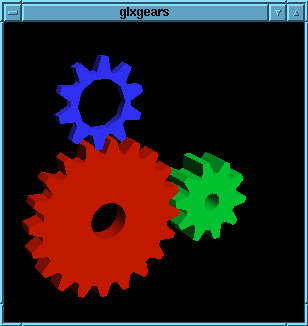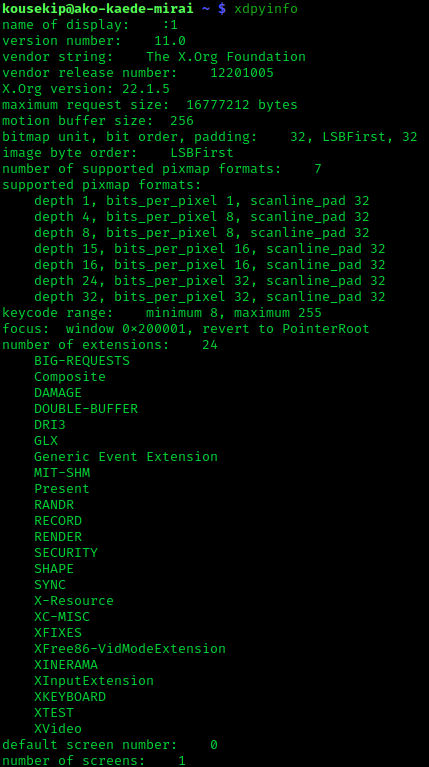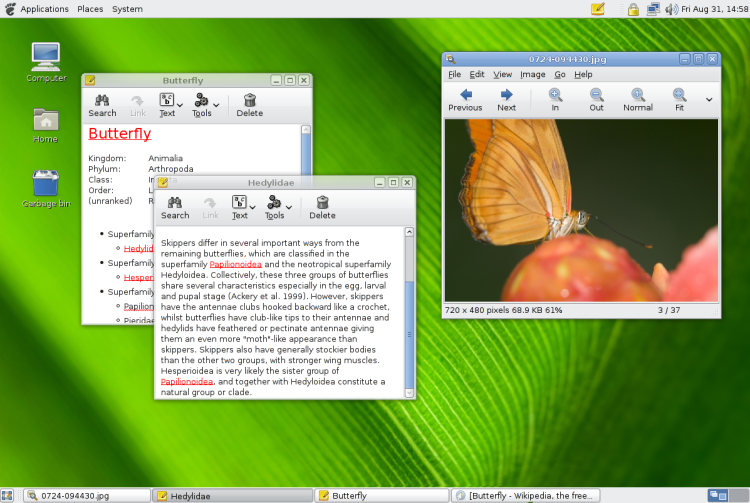|
GLX
GLX (initialism for "OpenGL Extension to the X Window System") is an extension to the X Window System core protocol providing an interface between OpenGL and the X Window System as well as extensions to OpenGL itself. It enables programs wishing to use OpenGL to do so within a window provided by the X Window System. GLX distinguishes two "states": indirect state and direct state. History Silicon Graphics developed GLX as part of their effort to support OpenGL in the X Window System. In 1999 SGI released GLX under an open-source license, letting it be incorporated in XFree86 source code version 4.0 in 2000. From there, the code was inherited by the forked X.Org Foundation version of the X Window System X11R6.7.0. On September 19, 2008, SGI created a new SGI FreeB License Version 2.0, which "now mirrors the free X11 license used by X.Org" and "meets the free and open source software community's widely accepted definition of 'free'". In 2009 the Free Software Foundation endorsed the ... [...More Info...] [...Related Items...] OR: [Wikipedia] [Google] [Baidu] |
AIGLX
Accelerated Indirect GLX ("AIGLX") is an Open-source software, open source project founded by Red Hat and the Fedora (operating system), Fedora community, led by Kristian Høgsberg, to allow accelerated indirect GLX rendering capabilities to the X.Org Server and Direct Rendering Infrastructure, DRI drivers. This allows remote X clients to get fully hardware accelerated rendering over the GLX protocol; coincidentally, this development was required for OpenGL compositing window managers to function with hardware acceleration. Rationale There are two ways in which a windowing system can allow an OpenGL implementation to talk to the graphics card. The first is to specify the OpenGL command stream in a portable network-neutral manner using a client/server implementation similar to the X11 drawing routines. This method, used by AIGLX, is indirect in that the drawing commands are sent to the X server and then the X server sends them along to the graphics card. The second way, whi ... [...More Info...] [...Related Items...] OR: [Wikipedia] [Google] [Baidu] |
Utah GLX
Utah GLX was a project aimed at creating a fully free and open-source basic hardware-accelerated 3D renderer using the OpenGL rendering API on Linux kernel-based operating systems. Utah GLX predates Direct Rendering Infrastructure, which is what is used as of 2014. John D. Carmack worked on Utah GLX. History File:Linux graphics drivers 2D.svg, 2D drivers inside of the X server File:Linux graphics drivers Utah GLX.svg, Indirect rendering over GLX, using Utah GLX File:Linux graphics drivers DRI early.svg, early Direct Rendering Infrastructure File:Linux graphics drivers DRI current.svg, Finally all access goes through the Direct Rendering Manager File:Linux graphics drivers DRI Wayland.svg, In Linux kernel 3.12 ''render nodes'' were merged and the KMS driver The Direct Rendering Manager (DRM) is a subsystem of the Linux kernel responsible for interfacing with GPUs of modern video cards. DRM exposes an API that user-space programs can use to send commands and data to the GPU ... [...More Info...] [...Related Items...] OR: [Wikipedia] [Google] [Baidu] |
Direct Rendering Infrastructure
The Direct Rendering Infrastructure (DRI) is the framework comprising the modern Linux graphics stack which allows unprivileged user-space programs to issue commands to graphics hardware without conflicting with other programs. The main use of DRI is to provide hardware acceleration for the Mesa implementation of OpenGL. DRI has also been adapted to provide OpenGL acceleration on a framebuffer console without a display server running. DRI implementation is scattered through the X Server and its associated client libraries, Mesa 3D and the Direct Rendering Manager kernel subsystem. All of its source code is free software. Overview In the classic X Window System architecture the X Server is the only process with exclusive access to the graphics hardware, and therefore the one which does the actual rendering on the framebuffer. All that X clients do is communicate with the X Server to dispatch rendering commands. Those commands are hardware independent, meaning that the ... [...More Info...] [...Related Items...] OR: [Wikipedia] [Google] [Baidu] |
Compiz
Compiz () is a compositing window manager for the X Window System, using 3D graphics hardware to create fast compositing desktop effects for window management. Effects, such as a minimization animation or a cube workspace, are implemented as loadable plugins. Because it conforms to the ICCCM conventions, Compiz can be used as a substitute for the default Mutter or Metacity, when using GNOME Panel, or KWin in KDE Plasma Workspaces. Internally Compiz uses the OpenGL library as the interface to the graphics hardware. Hardware requirements Initially, Compiz only worked with 3D hardware supported by Xgl. Most NVIDIA and ATI graphics cards are known to work with Compiz on Xgl. Since May 22, 2006 Compiz works on the standard X.Org Server, by using AIGLX. Besides Intel GMA graphics cards, AIGLX also supports using AMD graphics cards (including R300 and newer cards) using the open-source driver which supports since fall 2006. NVIDIA's binary drivers (since Version 1.0-9629) support ... [...More Info...] [...Related Items...] OR: [Wikipedia] [Google] [Baidu] |
Glamor (software)
X.Org Server is the free and open-source implementation of the X Window System display server stewarded by the X.Org Foundation. Implementations of the client-side X Window System protocol exist in the form of ''X11 libraries'', which serve as helpful APIs for communicating with the X server. Two such major X libraries exist for X11. The first of these libraries was Xlib, the original C language X11 API, but another C language X library, XCB, was created later in 2001. Other smaller X libraries exist, both as interfaces for Xlib and XCB in other languages, and as smaller standalone X libraries. The services with which the X.Org Foundation supports X Server include the packaging of the releases; certification (for a fee); evaluation of improvements to the code; developing the web site, and handling the distribution of monetary donations. The releases are coded, documented, and packaged by global developers. Software architecture The X.Org Server implements the server side of ... [...More Info...] [...Related Items...] OR: [Wikipedia] [Google] [Baidu] |
Compositing Window Manager
A compositing window manager, or compositor, is a window manager that provides applications with an off-screen data buffer, buffer for each window. The window manager Compositing, composites the window buffers into an image representing the screen and writes the result into the display memory. Compositing window managers may perform additional processing on buffered windows, applying 2D computer graphics, 2D and 3D computer graphics, 3D animated effects such as Alpha blending, blending, Dissolve (filmmaking), fading, Image scaling, scaling, Rotation (mathematics), rotation, Multi-monitor#Clone mode, duplication, bending and contortion, shuffling, Gaussian blur, blurring, redirecting applications, and Translation (geometry), translating windows into one of a number of Display device, displays and virtual desktops. Computer graphics technology allows for visual effects to be rendered in real time such as drop shadows, live previews, and complex animation. Since the screen is Double b ... [...More Info...] [...Related Items...] OR: [Wikipedia] [Google] [Baidu] |
EGL (API)
EGL is an interface between Khronos rendering APIs (such as OpenGL, OpenGL ES or OpenVG) and the underlying native platform windowing system. EGL handles graphics context management, surface/buffer binding, rendering synchronization, and enables "high-performance, accelerated, mixed-mode 2D and 3D rendering using other Khronos APIs." EGL is managed by the non-profit technology consortium Khronos Group. The acronym ''EGL'' is an initialism, which starting from EGL version 1.2 refers to ''Khronos Native Platform Graphics Interface''. Prior to version 1.2, the name of the EGL specification was ''OpenGL ES Native Platform Graphics Interface''. X.Org development documentation glossary defines EGL as "Embedded-System Graphics Library". Adoption * The BlackBerry 10 and BlackBerry Tablet OS mobile device operating system uses EGL for 3D graphics rendering. Both support EGL version 1.4. * The Android mobile device operating system uses EGL for 3D graphics rendering. * The Wayland ... [...More Info...] [...Related Items...] OR: [Wikipedia] [Google] [Baidu] |
Wayland (display Server Protocol)
Wayland is a communication protocol that specifies the communication between a display server and its clients, as well as a C library implementation of that protocol. A display server using the Wayland protocol is called a ''Wayland compositor'', because it additionally performs the task of a compositing window manager. Wayland is developed by a group of volunteers initially led by Kristian Høgsberg as a free and open-source community-driven project with the aim of replacing the X Window System with a modern, secure simpler windowing system in Linux and other Unix-like operating systems. The project's source code is published under the terms of the MIT License, a permissive free software licence. As part of its efforts, the Wayland project also develops a reference implementation of a Wayland compositor called ''Weston''. Overview The Wayland Display Server project was started by Red Hat developer Kristian Høgsberg in 2008. Beginning around 2010, Linux desktop graphics ... [...More Info...] [...Related Items...] OR: [Wikipedia] [Google] [Baidu] |
X Window System
The X Window System (X11, or simply X) is a windowing system for bitmap displays, common on Unix-like operating systems. X provides the basic framework for a GUI environment: drawing and moving windows on the display device and interacting with a mouse and keyboard. X does not mandate the user interfacethis is handled by individual programs. As such, the visual styling of X-based environments varies greatly; different programs may present radically different interfaces. X originated as part of Project Athena at Massachusetts Institute of Technology (MIT) in 1984. The X protocol has been at version 11 (hence "X11") since September 1987. The X.Org Foundation leads the X project, with the current reference implementation, X.Org Server, available as free and open-source software under the MIT License and similar permissive licenses. Purpose and abilities X is an architecture-independent system for remote graphical user interfaces and input device capabilities. Each person using a ... [...More Info...] [...Related Items...] OR: [Wikipedia] [Google] [Baidu] |
Mesa (computer Graphics)
Mesa, also called Mesa3D and The Mesa 3D Graphics Library, is an open source implementation of OpenGL, Vulkan, and other graphics API specifications. Mesa translates these specifications to vendor-specific graphics hardware drivers. Its most important users are two graphics drivers mostly developed and funded by Intel and AMD for their respective hardware (AMD promotes their Mesa drivers Radeon and RadeonSI over the deprecated AMD Catalyst, and Intel has only supported the Mesa driver). Proprietary graphics drivers (e.g., Nvidia GeForce driver and Catalyst) replace all of Mesa, providing their own implementation of a graphics API. An open-source effort to write a Mesa Nvidia driver called Nouveau is mostly developed by the community. Besides 3D applications such as games, modern display servers ( X.org's Glamor or Wayland's Weston) use OpenGL/ EGL; therefore all graphics typically go through Mesa. Mesa is hosted by freedesktop.org and was initiated in August 1993 by Brian Paul ... [...More Info...] [...Related Items...] OR: [Wikipedia] [Google] [Baidu] |
Mesa 3D
Mesa, also called Mesa3D and The Mesa 3D Graphics Library, is an open source implementation of OpenGL, Vulkan, and other graphics API specifications. Mesa translates these specifications to vendor-specific graphics hardware drivers. Its most important users are two graphics drivers mostly developed and funded by Intel and AMD for their respective hardware (AMD promotes their Mesa drivers Radeon and RadeonSI over the deprecated AMD Catalyst, and Intel has only supported the Mesa driver). Proprietary graphics drivers (e.g., Nvidia GeForce driver and Catalyst) replace all of Mesa, providing their own implementation of a graphics API. An open-source effort to write a Mesa Nvidia driver called Nouveau is mostly developed by the community. Besides 3D applications such as games, modern display servers ( X.org's Glamor or Wayland's Weston) use OpenGL/ EGL; therefore all graphics typically go through Mesa. Mesa is hosted by freedesktop.org and was initiated in August 1993 by Brian Paul ... [...More Info...] [...Related Items...] OR: [Wikipedia] [Google] [Baidu] |
XFree86
XFree86 is an implementation of the X Window System. It was originally written for Unix-like operating systems on IBM PC compatibles and was available for many other operating systems and platforms. It is free and open source software under the XFree86 License version 1.1. It was developed by the XFree86 Project, Inc. The lead developer was David Dawes. The last released version was 4.8.0, released December 2008. The last XFree86 CVS commit was made on May 18, 2009; the project was confirmed dormant in December 2011. For most of the 1990s and early 2000s, the project was the source of most innovation in X and was the ''de facto'' steward of X development. Until early 2004, it was almost universal on Linux and the BSDs. In February 2004, with version 4.4.0, The XFree86 Project began distributing new code with a copyright license that the Free Software Foundation considered GPL incompatible. Most open source operating systems using XFree86 found this unacceptable and moved to a f ... [...More Info...] [...Related Items...] OR: [Wikipedia] [Google] [Baidu] |



